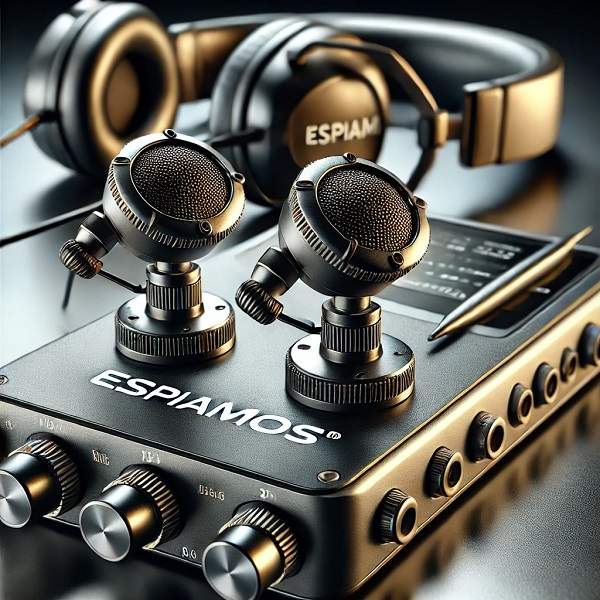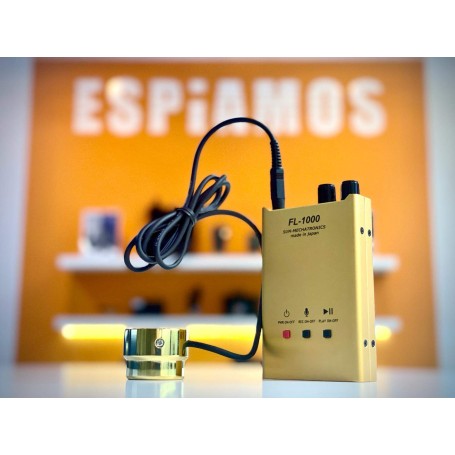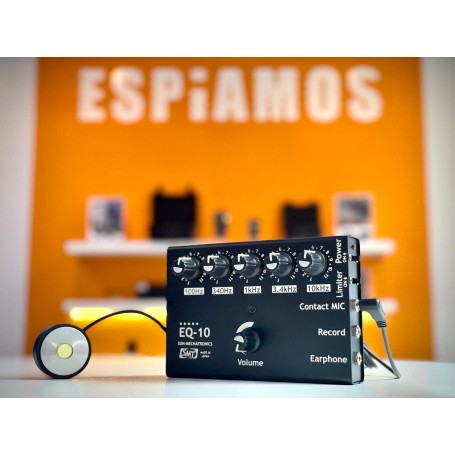Choosing the best contact microphone for listening through walls is essential to achieving effective results in your surveillance operations. These types of devices allow you to pick up sounds through solid surfaces such as walls and ceilings, and are key tools for private investigators, law enforcement, and other espionage professionals.

Table of Contents
- Introduction to Contact Microphones
- Key Features in a Contact Microphone
- Needle Probe vs. Flat Probe – Which to Choose?
- Frequency Adjustment to Improve Listening
- Device Autonomy and Durability
- Conclusion
- Contact Mics FAQ
Introduction to Contact Microphones
Wall microphones are devices designed to pick up sounds through solid surfaces such as ceilings or doors. They work by detecting the vibrations produced by sound waves as they pass through these surfaces, transforming those vibrations into audible signals. They are widely used in the field of security and surveillance due to their ability to operate discreetly and effectively.
These microphones are indispensable for operations where listening and recording without being detected is essential. Over the years, contact microphone technologies have evolved considerably, improving sound quality and making it easier to adjust frequencies and use in various conditions. However, choosing the best device can depend on several key factors that we will discuss below.
Key Features in a Contact Microphone
When selecting a contact microphone, it is essential to consider a number of features that will determine its performance and effectiveness. Not all contact microphones offer the same performance, and choosing the right one can significantly improve the quality of your surveillance. Here are the essential features you should consider before making a decision.
Sound Pickup Quality
Sound quality is one of the most important aspects. A good contact microphone should be able to pick up clear and precise sounds, even through dense surfaces such as concrete. To ensure sound quality, it is advisable to opt for models that have filters or equalizers that allow you to adjust sound frequencies and eliminate background noise.
Microphones that incorporate sound-tuning technology also offer the ability to amplify voices and reduce environmental interference. This is especially useful in operations where precision is crucial, and can make all the difference to the quality of hearing.
Portability and Design
Portability and compact design are key factors, especially if the device is to be used on covert missions or in different locations. A contact microphone should be lightweight and easy to carry, but without sacrificing sound quality or functionality. Models with an ergonomic and compact design will allow you to operate it more easily and discreetly.
Additionally, a good contact microphone should be durable to withstand constant use in various conditions. Durable materials and build quality will ensure that the device can perform optimally even in harsh or difficult environments.
Needle Probe vs. Flat Probe: Which to Choose?
One of the most important aspects when selecting a contact microphone is the type of probe. The probe is the part that comes into direct contact with the surface to pick up the vibrations and transform them into sound. There are two main types of probes: needle probe and flat probe , each with specific applications depending on the environment of use.
Needle Probe
The needle probe is ideal for penetrating thin surfaces such as doors, wood panels or light walls. The narrow, tapered design allows direct pickup of vibrations, resulting in clearer sound when the surface thickness is reduced. This type of microphone is very useful in scenarios where fine details need to be captured in a controlled environment.
Advantages: The main advantage of the needle probe is its ability to obtain precise pickups at specific points. This allows the operator to hear very clearly through thin surfaces, managing to pick up conversations without interference.
Disadvantages: The needle probe is more fragile than other types of probes, so it can be damaged if used on hard surfaces such as concrete or metal. It is also not the best choice for picking up sounds through thicker walls, where vibrations are not transmitted as directly.
Flat Probe
On the other hand, the flat probe is designed to offer greater durability and versatility. Instead of penetrating the surface, it distributes vibrations along its entire structure, allowing for a wider and more uniform sound pickup, especially useful on denser surfaces such as concrete or metal walls.

Advantages: The main advantage of the flat probe is its robustness . Being more resistant than the needle probe, it withstands adverse conditions better and can be used on a wider variety of surfaces. Its ability to pick up vibrations on thick surfaces makes it ideal for surveillance missions in industrial environments or in buildings with very thick walls.
Disadvantages: Although the flat probe is more durable, it does not provide the pinpoint accuracy of the needle probe, which can be a drawback in scenarios where detailed imaging is required on thin surfaces or in very localized areas.
Which One to Choose?
The choice between a needle probe or a flat probe depends on the type of surface and the environment you will be monitoring in. If you will be working on thin surfaces or where extreme precision is required, the needle probe will be the best choice. However, if the conditions are more demanding, with thick or hard surfaces, the flat probe will provide you with greater durability and better sound pickup in those more challenging situations.
In short, choosing the right type of probe is essential to optimize monitoring and obtain the best results in sound capture, adapting the device to the characteristics of the operating environment.
Frequency Adjustment to Improve Listening
One of the advanced features offered by the best contact microphones is the ability to adjust sound frequencies. This feature allows you to improve the quality of your listening in environments with a lot of background noise. Through an equalizer or frequency filters, you can eliminate unwanted sounds and amplify key frequencies, such as voices.
Microphones with adjustable filters are particularly useful in urban or industrial areas, where ambient noise can interfere with surveillance. The ability to filter and adjust frequencies will allow you to focus on important conversations and reduce interference that could affect audio clarity.
Device Autonomy and Durability
The battery life of a contact microphone is a crucial factor, especially in extended surveillance operations. Choosing a device with a good battery life will allow you to keep the microphone running for long listening sessions without the need to constantly recharge it. For example, some models such as the Sun Mechatronics EQ-10 offer up to 75 hours of battery life, making them an excellent choice for missions that require long hours of operation.

Additionally, the durability of the device is key, as in covert operations or in adverse conditions, the microphone must be able to withstand shocks, extreme temperatures or difficult conditions without compromising its performance. A good contact microphone should be made of durable materials that allow it to maintain its sound quality and functionality in any type of environment.
Rechargeable Battery vs. Conventional Batteries
Some contact microphones come equipped with rechargeable batteries, while others use conventional batteries, such as AA batteries. The choice between these two types of power will depend on your needs. Rechargeable batteries are usually more practical for frequent use, as you do not need to constantly change the batteries. However, devices that use AA batteries can offer a longer initial battery life and may be more convenient in situations where it is not possible to recharge the device during operation.
So, if you have access to a power source to recharge, rechargeable batteries may be the best option. However, if your operation will take you into an environment without access to electricity, a device with conventional batteries may offer greater flexibility.
Ease of Use and Configuration
A key aspect when choosing a contact microphone is ease of use. Not all professionals who use these devices have technical training, so it is important that the microphone is intuitive and easy to set up. The best contact microphones are designed to be operated without the need for specialized training, allowing the user to start listening and recording immediately.
Intuitive Interface and Adjustable Controls
A good contact microphone should have a clear interface with simple controls for adjusting volume, sound filters and frequency. This allows for quick setup in time-critical situations, which is especially important in covert or surveillance operations. Devices such as the Sun Mechatronics FL1000 feature intuitive controls that make them easy to operate, even under stressful conditions.
In addition, the most advanced models feature battery and signal indicators, giving the user a clear view of the status of the device at all times. These indicators are essential to ensure that the microphone is working properly during prolonged operation, avoiding possible failures or interruptions in listening.
Configuration and Transportability
Portability and ease of setup are also essential. Microphones that are quick to install and do not require additional tools or complex configurations allow the user to act more agilely. Devices with a compact and lightweight design are ideal for operations where constant mobility is required or when maintaining a low profile is important.
Some models allow immediate use with headphones for direct listening or portable recorders for storing audio, without the need for complicated technical configuration. This makes contact microphones versatile and adaptable to any surveillance situation.
Conclusion
Choosing the best contact microphone for listening through walls depends on several factors such as sound quality, durability, battery life, and ease of use. Security and investigation professionals need reliable and advanced tools to accomplish their missions, and a quality contact microphone is one of the best investments they can make.
The versatility and precision of these devices make them indispensable for those seeking efficient and discreet surveillance. Whether it is for private investigations or government security operations, a good contact microphone, such as the models fromSun Mechatronics , can make all the difference in the quality of the information obtained.
In short, consider your specific needs when evaluating the features of each device. Whether you need long battery life, precise frequency tuning, or easy setup, the market offers several options tailored to different surveillance scenarios. With the right choice, you'll have a reliable and long-lasting tool in your hands that will elevate your surveillance operations to a new level.
Frequently Asked Questions (FAQ)
1. What is a contact microphone and how does it work?
A contact microphone is a device designed to pick up sounds through solid surfaces, such as walls, ceilings or doors. It works by detecting the vibrations produced by sound waves passing through these surfaces. These vibrations are converted into electrical signals which are then amplified, allowing the sound to be heard on headphones or recorded on a storage device.
2. In what scenarios is a contact microphone most useful?
Contact microphones are especially useful in professional surveillance scenarios, such as private investigations, police or security operations, and undercover missions. They are also very effective in environments where information needs to be obtained without being detected, such as in high-security buildings or during surveillance in areas where conventional microphones cannot be installed.
3. What are the advantages of flat probe microphones over needle probe microphones?
Flat probe microphones are more durable and less prone to damage than needle probe microphones. They also allow for better vibration distribution, which improves the quality of the captured sound. Needle probe microphones, on the other hand, are more effective at penetrating thin surfaces, but can be more fragile and less versatile in demanding environments.
4. How important are frequency filters in contact microphones?
Frequency filters allow you to remove unwanted noise and amplify key frequencies, such as human voices, significantly improving sound clarity. This is crucial in noisy environments, such as urban or industrial areas, where background noise can make it difficult to accurately pick up important conversations. A microphone with an equalizer or adjustable filters will be more effective in adapting to different surveillance environments.
5. How long does the battery of a contact microphone last?
Battery life varies by model. Some contact microphones, such as the Sun Mechatronics EQ-10, can offer up to 75 hours of continuous use, while other, more compact models can have 30 to 50 hours of battery life. If your operation requires extended use without the possibility of recharging, it is important to choose a microphone with a long-lasting battery or one that allows the use of conventional batteries.
6. Is it difficult to set up and use a contact microphone?
No, contact microphones are designed to be easy to set up and use, even for those with no technical background. Most models offer intuitive controls for adjusting volume and frequencies, and can easily connect to headphones or recorders without the need for complex setup. Models like the Sun Mechatronics FL1000 are known for their simplicity of use.
7. How discreet are contact microphones?
Contact microphones are extremely discreet due to their compact size and do not need to be visibly mounted on a surface. Most are temporarily mounted on a wall or door and can operate undetected. Their small size and portability make them ideal for missions where discretion is a priority.
8. Can I record audio captured by a contact microphone?
Yes, many contact microphones include a built-in recording system or the ability to connect to an external recorder. For example, the Sun Mechatronics MW-55 has an internal recording system that allows conversations to be stored in its memory, while other models allow connection to a portable recorder to store long surveillance sessions.
9. Are contact microphones resistant to adverse conditions?
The best contact microphones, such as those made by Sun Mechatronics, are designed to be durable and perform under harsh conditions. These devices are typically resistant to dust and heavy outdoor use, making them suitable for operations in harsh weather conditions or environments where the equipment may be exposed to shock or movement.
10. Is it legal to use contact microphones for surveillance?
The use of contact microphones for surveillance is regulated by the privacy laws of each country. In many cases, the use of these devices is permitted only for security professionals, such as private investigators or law enforcement, who act within the confines of the law. It is important to check local regulations before using contact microphones to ensure compliance with current regulations.






 WhatsApp
WhatsApp Telegram
Telegram


